
"We should not wait" to shore up Social Security and Medicare, said Treasury Secretary Tim Geithner.
NEW YORK (CNNMoney) -- Social Security and Medicare -- the country's two biggest entitlement programs -- will run dry earlier than expected, according a report Friday from the programs' trustees.
After the programs' trust funds are exhausted, Social Security and Medicare will be taking in only enough money to pay a portion of promised benefits to retirees.
Combined, the cost of the programs represented 8.4% of the size of the nation's economy last year -- a figure that would jump to 11.8% by 2035.
The reason: The number of beneficiaries will explode as more Baby Boomers retire and lower birth rates will slow growth in the number of workers paying into the system. (How entitlements will eat up tax dollars)
Treasury Secretary Tim Geithner urged policymakers to take steps to shore up the two programs.
"We should not wait for the trust funds to be exhausted to make the reforms necessary to protect our current and future retirees," he said. "Larger, more difficult adjustments will be necessary if we delay reform."
Social Security will have sufficient resources to pay 100% of promised benefits through 2036. That's one year earlier than last year's forecast because the economic recovery has been slower than expected and seniors are living longer.
After 2036, the program will only be able to pay 77% of promised benefits.
Last year was the first time the program took in less payroll tax revenue than the benefits paid out. The difference was made up by the interest paid to the program by its trust fund.
That fund reflects the $2.6 trillion of surplus revenue paid into the program since 1983. The surplus revenue, however, was spent over the years by the government and in exchange it issued non-marketable U.S. bonds to the trust fund.
As the program starts redeeming those bonds, the Treasury will need to either borrow more money, raise taxes or cut spending, since the country is already operating in deficit.
The financial outlook for Social Security disability benefits, which is included in the overall trust fund, is considerably worse than it is for retirement benefits.
The trust fund money dedicated to disability benefits, which are paid to people who can't work because of a medical condition, is projected to run out by 2018. The program's costs have been outpacing its non-interest income since 2005.
One way to grasp the size of Social Security's long-term shortfall, including the disability program, is to consider how much the 12.4% payroll tax rate on the first $106,800 of a worker's wages would need to go up immediately to ensure the program can pay full benefits over the next 75 years. The trustees estimate that it would need to be reset at 14.62%.
Put another way, the trust fund would need an additional $6.5 trillion in current dollars to pay all scheduled benefits in full over the next 75 years.
Meanwhile, Medicare's hospital insurance program, otherwise known as Part A, should be able to pay full benefits through 2024, the trustees project. That is five years earlier than they predicted last year.
But 2024 is still eight years later than had been projected before Congress passed the new health reform law. (The ugly math of Medicare)
As he did last year, however, the program's chief actuary, Richard Foster, expressed strong skepticism about the report's assumptions that the new health reform law will be carried out as written.
Among the reasons for his skepticism: The trustees' report assumes that scheduled reductions in fees to Medicare doctors will take place, even though Congress regularly overrides such reductions.
By 2025, the hospital trust fund will have run out and the program will be able to pay only 90% of hospital costs. By 2045, that share will drop to 75% before gradually climbing back up.
To cure the program's long-term shortfall, the 1.45% Medicare payroll tax rate on all of a worker's wages would need to increase by just under 1 percentage point starting today.
In addition to Part A, the main Medicare benefit, there are two supplementary programs: Part B for doctor bills and Part D for drug coverage. They are funded solely by general tax revenue and patient-paid premiums.
Costs for those programs, however, are set to rise rapidly -- and that means growing pressure on the federal budget and seniors. ![]()
| Latest Report | Next Update |
|---|---|
| Home prices | Aug 28 |
| Consumer confidence | Aug 28 |
| GDP | Aug 29 |
| Manufacturing (ISM) | Sept 4 |
| Jobs | Sept 7 |
| Inflation (CPI) | Sept 14 |
| Retail sales | Sept 14 |